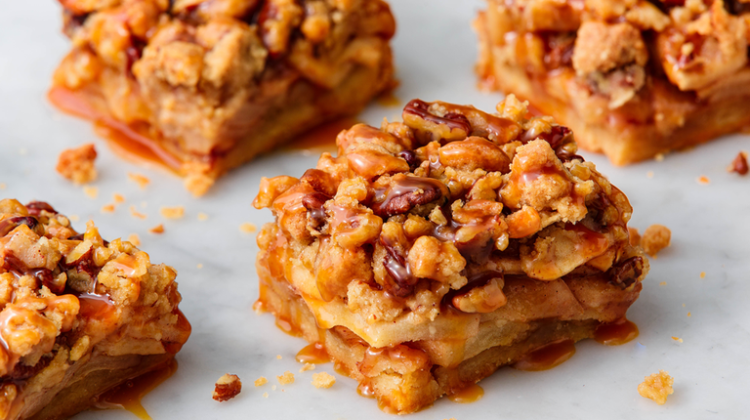
Apple Pie Bars. Photo by: Parker Feierbach.
The weather is getting colder, leaves are fading, and it’s officially fall. People are finally harvesting their fruits, veggies, and cannabis and I couldn’t be more excited to share this fall-inspired infusion.
These Apple Pie Bars from Delish (with an infused twist) perfectly embody the flavors of Fall. For extra fun and flavor, one can get into the spirit and pick their own fresh apples!
Since it’s also the perfect time to pick grapes, I thought I’d would share a nice wine pairing. Tawny Port perfectly highlights the caramel from the apple pie bars and also adds a hint of raisin. This wine is on the sweeter side and typically has a higher than normal alcohol content. A medley of apples, caramel, and raisins is sure to make consumers fall in love with the flavors of a fresh harvest.
Predicting Effects of CBD and THC
Consuming cannabis in an edible form is a great way to enjoy cannabis, especially for anyone who wants to avoid lung damage from smoking. That said, edible cannabis can be difficult to dose properly due to its longer onset times and increased potency compared to inhalation.
For example, Leafly reports that it can take up to an hour to feel the effects of edibles. Furthermore, Encore Labs explains that the effects are longer lasting than smoking cannabis, with a more intense and fuller body high.
Due to the nature of edible cannabis, it’s important that consumers determine the right cannabis for them. According to Healthline, there are 120 different phytocannabinoids that are present in cannabis plants; each can yield different effects. The most popular are CBD and THC, which both can have healing properties.
CBD is good for anyone new to cannabis since it is non-psychoactive and doesn’t usually cause negative side effects. THC is responsible for the “high” feeling and is the primary psychoactive compound in cannabis. While one can’t overdose from THC, if too much is taken, its effects can be uncomfortable and last for hours. Cannabis affects everyone differently so it is important to always start at low dose and work up from there. Calculating one’s edibles dosage can help consumers avoid taking too much. For helpful dosing:
(grams of flower) x 1000 x (percentage of THC) = total milligrams
Example: If one has 3.5 g of flower containing 20% THC, that would be a maximum of 700 mg of THC (3.5 x 1000 x 0.2 = 700).

Aromas and Flavors of Terpenes
Not only does cannabis contain cannabinoids, it also contains terpenes. Terpenes are responsible for the way cannabis looks and smells, but are present in many other types of plants as well, according to Healthline. They also hypothesize that cannabis’ dominant terpenes will determine the effect of the cannabis, but there is still more research to be done.
Knowing the terpene profile of one’s cannabis is helpful to get the right flavor and effect out of an infusion. This Cannabis Terpene Chart from THC Design can help consumers learn more about the different flavors and effects of certain strains.
For this recipe try something that is dominated with linalool and beta-caryophyllene. Jamie Evans, writer of many cannabis cookbooks, describes linalool to taste like lavender while providing a blissful, rejuvenated effect. Additionally, Evans says beta-caryophyllene is reminiscent of cinnamon spice and gives a calming, sedated effect. Not only do the flavors pair well with apple pie, but they also provide a nice effect for someone looking to relax at the end of a long day.
Preparing Infusions
Before infusing cannabis, always take the step of decarboxylation. According to Cooking with Laurie + MaryJane, the process of decarboxylating cannabis turns THC and CBD into their active forms. At home, one can use an oven to decarboxylate flower. To do this, simply break up the nugs of flower into smaller pieces, put it on a baking sheet with some parchment paper, and throw it in the oven.

But, be careful not to over heat the cannabis since Weedmaps’ Decarboxylation Explained with Temperature Charts shows too high of a temperature or too much time can destroy terpenes and other compounds. This yields a less effective and less flavorful end result.
Different sources online all swear that their methods for decarbing are the best so it can be tricky to find the right time and temperature. I liked the method Cooking with Laurie + MaryJane used which used the oven at 240℉ for 40 minutes. This protects the full terpene and phytocannabinoid profile of the cannabis.
Now that the cannabis is all activated, it’s time for the actual infusion. For this recipe, I chose to infuse the butter in the bottom crust for easy portioning. My personal favorite method for infusing butter involves the use of a crockpot. Crockpot Cannabis Butter is easy, low maintenance, and gets better the longer you leave it in.
Once the flower is decarboxylated, add it to your crockpot with 1 cup of water and 1 cup of butter. Set your crockpot on low for at least three hours before straining the mixture through a cheesecloth. Put the butter in the fridge to allow it to harden while leaving the water behind. Then strain the water, leaving a lovely puck of cannabutter.

Infused Apple Pie Bars

Serves: 18
Start to finish: 2 hours and 15 minutes
FOR THE CRUST:
1 cup (2 sticks) cannabutter, softened
1/2 cup granulated sugar
1/4 cup packed brown sugar
2 1/2 cup all-purpose flour
1/2 tablespoon salt
FOR THE FILLING:
6 apples, peeled, cored, and sliced
Juice of 1/2 lemon
1/2 cup packed brown sugar
1 tablespoon cinnamon
1 tablespoon pure vanilla extract
1/2 tablespoon salt
FOR THE TOPPING
1 1/2 cup all-purpose flour
1 cup chopped pecans
1 cup packed brown sugar
1/2 tablespoon salt
3/4 cup (1 1/2 sticks) butter, melted
Caramel for topping
Preheat the oven to 350℉. Line 9 by 13 inch pan with parchment paper. Be sure to add cooking spray or butter to paper to help avoid sticking.
Now it’s time to make the crust. First, using a hand mixer or whisk, mix non-infused butter and sugars together until the mixture becomes light and fluffy. Then add flour and salt, and mix.
Press down the mixture onto the pan/paper with hands so that it’s about a half inch deep before baking 20 minutes — the crust should be lightly golden brown.
In a large bowl toss peeled, sliced apples with lemon juice, brown sugar, cinnamon, vanilla, and salt. Apply it evenly over crust.
Now, it’s time for the topping. In a separate bowl, use whisk to mix flour, pecans, brown sugar and salt. Stir in cannabutter until mixture begins to clump.
Now, sprinkle topping over apple mixture, using hands to break it up. Then, bake until golden brown and apples are nice and soft (use a fork to test if apples are soft). This should take roughly an hour.
Let cool for 15-20 minutes before cutting, drizzling bars with caramel and enjoying.


Leave a Reply